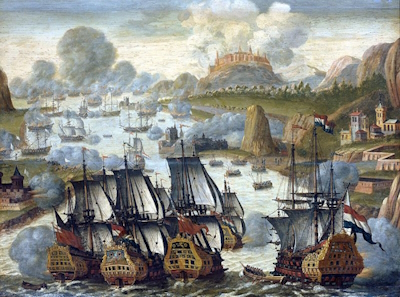 The War of Spanish Succession was fought in Europe and the colonies between 1701 and 1714. The theatre of war in the Americas was known as Queen Anne’s War and involved a series of smaller wars fought by British colonists against the French and their native American allies.
The War of Spanish Succession was fought in Europe and the colonies between 1701 and 1714. The theatre of war in the Americas was known as Queen Anne’s War and involved a series of smaller wars fought by British colonists against the French and their native American allies.
In 1700 King Charles II, the last Spanish King of the House of Habsburg, died with no direct heir to take over the throne of Spain. Before he died, he had named his half sister’s grandson, the Duke of Anjou, Phillip of Bourbon, as his successor to the Spanish crown under the name Felipe V. Felipe was also in the line of succession to the French throne. A Bourbon monarch on the throne of France and Spain would greatly shift the balance of power in Europe and quash the ambitions of Britain and the Dutch Republic.
Although Felipe V’s sovereignty was grudgingly accepted at first, it was when the Bourbon’s cut off England and the Dutch Republic from Spanish trade that war broke out between the two main factions in Europe – the conflict being known as the War of the Spanish Succession. One faction consisted of an alliance between France under Louis XIV, Bourbon Spain, Bavaria, and Cologne; the other faction was made up of a coalition between Austria, England, the Dutch Republic and Portugal, whose contender for the throne of Spain was Archduke Charles, crowned Carlos III in Vienna. Savoy initially supported France but later joined the Grand Alliance. When Carlos III reached Spain, support was declared for him in Aragon, Catalonia and Valencia, but he was driven out in 1706, after which the Bourbons then conquered Aragon and Valencia. Meanwhile the British had seized Menorca.
Although the French held the advantage in the early stages after success at the battle of Höchstädt, the Grand Alliance achieved a bloody victory over them at Blenheim in 1704, which they failed to follow up on. The French and their allies were forced into the defensive after 1706. The Battle of Almansa, fought in 1707, was one of the most decisive engagements of the war, where the Franco-Spanish army under Berwick soundly defeated the allied forces of Portugal, England, and the United Provinces led by the Earl of Galway, reclaiming most of eastern Spain for the Bourbons. By 1710 the Allies had failed to make any significant progress, while Bourbon victories in Spain had secured Felipe’s position as king. When Emperor Joseph I died in 1711, Archduke Charles succeeded his brother as emperor, and a newly elected British government initiated peace talks, which resulted in several treaties being signed between 1713 and 1714 known as the Peace of Utrecht.
Save for some small but significant changes and concessions, the face of Europe at the conclusion of the war did not differ greatly from that before its outbreak:
- The Bourbon monarch Felipe V was confirmed as King of Spain, but the monarchs of Spain and France had to renounce their claim to both thrones, so that descendents couldn’t inherit them in order to prevent the two kingdoms becoming one and shifting the balance of power.
- France was restricted to its pre-war borders. No losses, no gains in territory.
- France withdrew backing for the exiled Jacobites and recognised the Hanoverians as heirs to the British throne.
- The British obtained control of Gibraltar and Menorca, also acquiring significant trade concessions in the Spanish Americas, and they replaced the Dutch as the leading maritime and commercial European power.
- The Spanish Empire remained largely intact, but ceded territories in Italy and the Low Countries to Austria and Savoy.
- The Dutch gained a strengthened defence line in what became the Austrian Netherlands, and although they remained a major commercial power, the cost of the war permanently damaged their economy.
- The decentralisation of the Holy Roman Empire continued, with Prussia, Bavaria and Saxony increasingly acting as independent states, and combined with victories over the Ottomans, Austria increasingly switched its focus to southern Europe.
For more information on the war and Spanish wars in general check out the website The Spanish War History. If you’re interested in maps and manuscripts from the period thae a look at The Royal Collection Trust website.
You can watch a short video giving a summary of the war by Tom Richey on Youtube.
